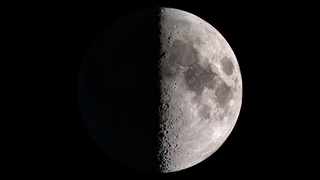Planets and Moons
ID: 4675
The most visible change in the appearance of the Moon is its monthly cycle of phases. Every 29.5 days, the Moon changes from a thin crescent low in the western sky in early evening, to a full disk that rises at sunset and is up all night, back to a thin crescent rising just before sunrise. The Moon's phases are caused by its orbit around the Earth. As the Moon circles us, different parts of it face the Sun. When the side of the Moon facing the Earth is sunlit, we see a full Moon. When the Sun is up on the far side of the Moon, we see a thin crescent, or nothing at all.
This animation shows the sunlit and shadowed portions of the Moon over the course of a month. The video can loop continuously. Viewers on all sides of the sphere see a full progression of lunar phases like those visible from Earth. Viewers facing the near side of the Moon will also see Earthshine, light reflected from the Earth that faintly illuminates the night side of the crescent Moon.
Amateur astronomers pay particular attention to features near the terminator, the line dividing day and night on the Moon. Long shadows and high contrast near the terminator bring out details in the terrain that are hard to see at other times. The animation uses elevation data from Lunar Reconnaissance Orbiter's laser altimeter to recreate this sense of heightened detail near the terminator.
Moon Phases for Spherical Displays
This animation shows the sunlit and shadowed portions of the Moon over the course of a month. The video can loop continuously. Viewers on all sides of the sphere see a full progression of lunar phases like those visible from Earth. Viewers facing the near side of the Moon will also see Earthshine, light reflected from the Earth that faintly illuminates the night side of the crescent Moon.
Amateur astronomers pay particular attention to features near the terminator, the line dividing day and night on the Moon. Long shadows and high contrast near the terminator bring out details in the terrain that are hard to see at other times. The animation uses elevation data from Lunar Reconnaissance Orbiter's laser altimeter to recreate this sense of heightened detail near the terminator.
Related
Visualization Credits
Ernie Wright (USRA): Lead Visualizer
Laurence Schuler (ADNET Systems, Inc.): Technical Support
Ian Jones (ADNET Systems, Inc.): Technical Support
Laurence Schuler (ADNET Systems, Inc.): Technical Support
Ian Jones (ADNET Systems, Inc.): Technical Support
Please give credit for this item to:
NASA's Scientific Visualization Studio
NASA's Scientific Visualization Studio
Short URL to share this page:
https://svs.gsfc.nasa.gov/4675
Mission:
LRO (Lunar Reconnaissance Orbiter)
Data Used:
Note: While we identify the data sets used in these visualizations, we do not store any further details nor the data sets themselves on our site.
Keywords:
SVS >> Albedo
SVS >> Elevation data
SVS >> Laser Altimeter
SVS >> Lunar
SVS >> Moon
SVS >> Science On a Sphere
SVS >> LRO
SVS >> Lunar Reconnaissance Orbiter
SVS >> LOLA
SVS >> LROC
SVS >> Magic Planet
SVS >> Lunar Topography
SVS >> Lunar Elevation Map
SVS >> Solar System >> Moon >> Lunar Surface
NASA Science >> Planets and Moons
https://svs.gsfc.nasa.gov/4675
Mission:
LRO (Lunar Reconnaissance Orbiter)
Data Used:
LRO/LOLA/Digital Elevation Map also referred to as: DEM
Lunar Reconnaissance Orbiter/LRO Camera/Natural Color Hapke Normalized WAC Mosaic also referred to as: LROC WAC Color Mosaic
Mosaic - Arizona State University
This natural-color global mosaic is based on the 'Hapke normalized' mosaic from LRO's wide-angle camera. The data has been gamma corrected, white balanced, and range adjusted to more closely match human vision.
Keywords:
SVS >> Albedo
SVS >> Elevation data
SVS >> Laser Altimeter
SVS >> Lunar
SVS >> Moon
SVS >> Science On a Sphere
SVS >> LRO
SVS >> Lunar Reconnaissance Orbiter
SVS >> LOLA
SVS >> LROC
SVS >> Magic Planet
SVS >> Lunar Topography
SVS >> Lunar Elevation Map
SVS >> Solar System >> Moon >> Lunar Surface
NASA Science >> Planets and Moons












